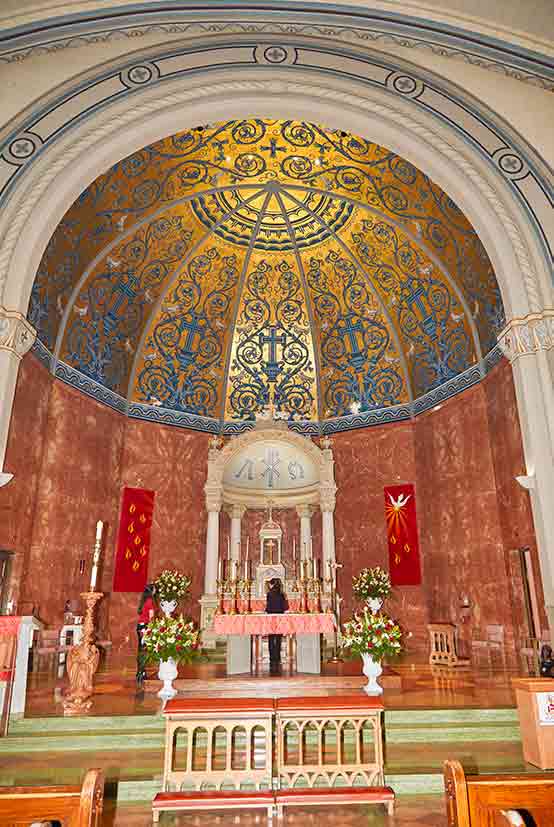Polish immigrants congregated not only on Milwaukee’s South side, but on the city’s Northeast as well. Most of the settlers had come from Prussia and suffered through Otto Von Bismarck’s repressive “Kulturkampf” against the Polish language and Catholic faith. It has been said that the East side of Milwaukee was known as the “Kepa Kazubow”, or “the islet of the Kashubes”. It as also known locally as the ”Koza Dory” or “Goat Yard.”
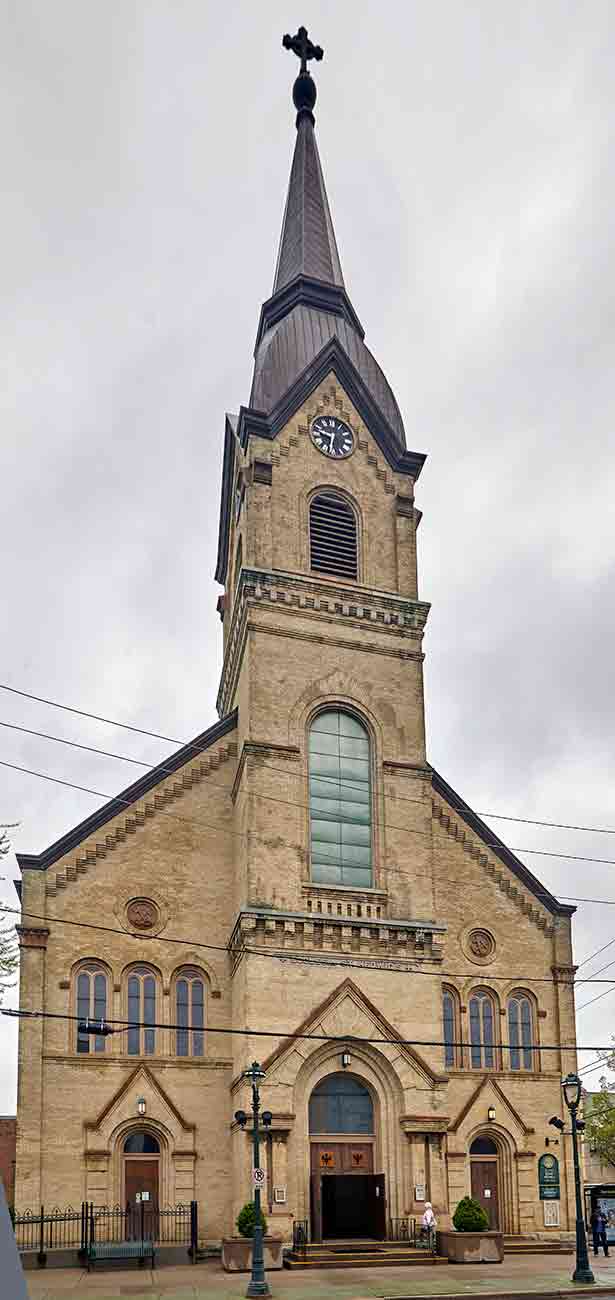
Most of these residents made their living working on boats or fishing as opposed to the southsiders who worked in factories. In the beginning, Polish residents from “Kepa” who wished to attend mass in their native language made a long and arduous journey on foot to St. Stanislaus, which literally took hours each way. Those who were not quite up to this task attended St. Mary’s on Broadway or St. John Nepomuc, a Bohemian church.
Following the completion of St. Stanislaus Church, the “Eastsiders” also became energized into organizing a Polish parish of their own. $1000 was donated as seed money from St. Stanislaus. Forty families had met on the edge of a deep ravine at the corner of Brady and Franklin streets in 1870 and agreed to initiate the project, but ten eventually declined preferring to attend services at a German parish. It was strictly a voluntary effort, with some parishioners charged with going door to door to raise funds while others purchased the necessary building materials from their own pockets. Other groups were organized in order to dig the foundation ditches, which they did in their very limited free time. Parishioner August Rudzinski headed up the project and purchased two lots at $200 apiece, and a third one was given to them for free.
A small wooden church was finally erected on the corner of Brady and Humboldt in 1871 at the cost of $11,000. The Milwaukee Sentinel at the time reported that these St. Hedwig families were among the poorest of the poor, with the men being engaged in sewer construction and public works.
The Archbishop of Milwaukee at the time, Johann Henni, blessed the new house of the Lord and appointed Father Piotr (Peter) Koncza as pastor who had studied at the St Francis Seminary. Father Koncza was from the province of Wilno in Lithuania and a newly ordained priest.
Mass was performed for the first time at St. Hedwig’s on October 17th, 1871. The first baptism at the church took place just a month later for one Helen Cecila Odya, the daughter of Joseph and Agnes Banaszenski. The following year, the first marriage ceremony was performed between Jacob Czupa and Mary Kalas as well as 34 more baptisms. It's a sign of the dynamic growth of the Polish parish.
A Capuchin from Warsaw, Father Xaverius Kralczynski, was chosen to replace Father Koncza after 18 months. Another in a long line of politically activist priests, Father Kralczynski had been known for preaching nationalist homilies in open fields to large crowds in Russian occupied eastern Poland, which at times numbered nearly 20,000 souls. But the crushing of a Polish insurrection in 1863 by the Tsarist police led to Father Xavier’s arrest and eventual imprisonment for his political activities.
After being released from prison, the priest journeyed to Rome and was originally assigned to a church in Turkey before arriving in America. Following a posting to a Polish church in Manitowoc, Father Kralczynsi was assigned to St. Hedwig’s in 1873. Under his guidance, a school was built for the parish children which needed to be expanded just a few years later to accommodate the growing demand. The Sisters of Notre Dame were charged with the providing instruction at the school and were assisted by laypeople Mr. Anthony Baska and Mrs. Eva Peplinski. The school focused on the teaching of religion, Polish and English. The parish put a particular emphasis on the teaching of Polish, as was explained earlier. It was felt that if the Poles simply assimilated into the American culture, they would lose everything.
Father Kralczynski would go on to serve the St. Hedwig’s for three more years. New homes continued to be built in the area and the ravines filled in. The proximity of the neighborhood to Lake Michigan allowed cool breezes to drift through it during the long, hot summer days, making it a desirable location to build a new home. The industrious Poles would eventually transform the entire area from a desolate swampland to an attractive community. Some of the new streets were named in honor of Polish heroes such as King Jan Sobieski and General Casimir Pulaski.
As the church grew, a pump, and an organ were added, as well as a small bell mounted in the tower. Carpenters constructed pews which were then rented out to parishioners to help pay for the upkeep and heating of the building which was supplied by a solitary aging stove, which proved inadequate for the long Wisconsin winters. A furnace was later installed in the basement, with just a single register near the Communion rail. Women tended to arrive early, rosary in hand, and stand near the register in order to warm up enough to get them through the service.
Parishioner Tomasz Klopotek established an insurance cooperative among the church members which eventually had 250 members. The group was named the St Adalbert BiM Alliance.
In 1875 a transfer of pastors took place. Due to discord among the parishioners at St. Stanislaus, Father Rodowicz of Saint Stan was exchanged with Father Kralcyznski. Upon his arrival at St. Hedwigs, Father Rodowicz decided that the old wooden school house would be sold at a raffle for one dollar per ticket to help raise money for a more substantial and larger structure. The raffle was won by Joseph Polczynski and the building was moved to the corner of Brady Street and Arlington Place, where it became a tavern.
The new school, a two story brick structure, was built and would later be remodeled into a home for the sisters. In 1884 a rectory for the pastor was constructed. Unfortunately, around this time conflicts also began to emerge among the parishioners at Saint Hedwig’s. As was the case in most Polish communities, there was a philosophical divide between those who wanted to retain the Polish language and culture, and others who wanted to adopt the ways of their new homeland. On September 19, 1885, Father Rodowicz chose an organist named Mr. Kowalski who spoke only Polish. His appointment had been opposed to by a group who objected to the fact that Kowalski would not be able to teach music to the English speaking children of the parish. A street riot ensued the day following the decision involving 100 parishioners and some 2,000 onlookers. The Milwaukee Police were called in to restore order after mobs damaged the rectory and several arrests were made. The Archbishop placed the parish under interdict and the church and school were both closed on September 20, 1885. As a result, Father Rodowicz was forced to resign from the parish in October 1885 and the church remained closed by the Archdiocese to allow tensions to subside. The unfortunate Father Rodowicz either seemed to have a knack for provoking arguments among his flock or may have just been in the wrong places at the wrong times. This was the second time a parish under his charter needed to be closed due to conflicts among its members. Father Rodowicz passed away in Baltimore in 1896.
A new pastor, Father Clement Rogozinski was appointed as a replacement. Father Rogozinski had been born in the Kingdom of Poland in 1835 and ordained in Łowicz in 1861 just as a national uprising by Poles was taking place. The provisional Polish government had chosen Father Rogozinski to administer the oath of allegiance to its rebel forces. After the uprising had been suppressed, Father Rogozinski attemped to escape south to Galicia but the Tsarist police eventually caught up with him and the priest was incarcerated in Olomuniec Prison for eleven months. After regaining his freedom, Father Rogozinski obtained a passport and traveled first to Paris, France and then to Texas. After ministering to German and Bohemian missions for four years, Father Rogozinski worked his way up to Beaver Dam, eventually landing in Milwaukee. Father Rogozinski was on a sabbatical in Europe when parishioners of St Hedwig’s petitioned to have their church and school reopened. Following his return, Holy Mass was said once again at the church on the corner of Humboldt and Brady Street following a three month absence.
Father Rogozinski was said to be a man of courage and determination and managed to eventually reconcile all of the feuding factions within the parish. After the dust had settled, the congregation quickly outgrew the original church structure which was only designed to serve two hundred parishioners. More than six hundred families were arriving each Sunday to worship at St. Hedwig’s.
The parish purchased two additional lots from a Mr. Kowalski (probably not the unfortunate organist) for $6000, and secured loans for an additional $15,000. Construction of a new church began in August of 1886.
The following year the new church was completed, having been designed in a combination of Gothic and Romanesque styles. The brickwork was cream in color, which was quite typical for buildings around Milwaukee at the time. Clay in the surrounding area lacked iron and had an abundance of lime and sulfur which brought a unique aspect to brick buildings in the city. The tan color of its bricks was the reason why Milwaukee became to be known as the “Cream City” (and not for an abundance of breweries or dairies). The uniquely colored bricks were commonly exported throughout the world.
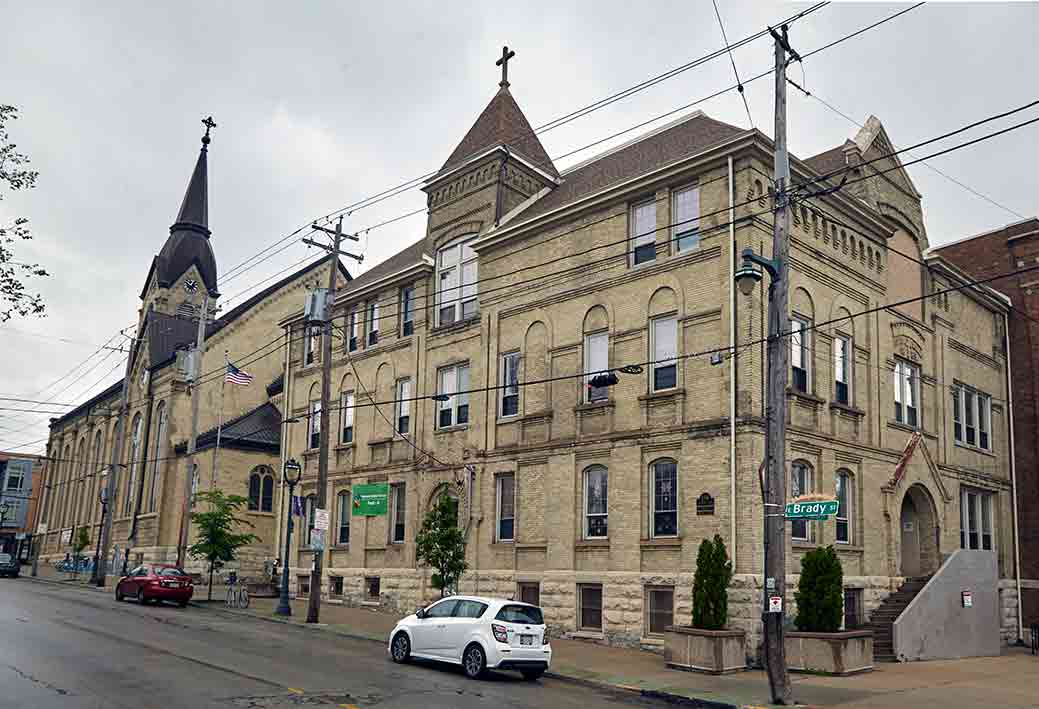
The new St Hedwig’s structure was 153 feet long and 65 feet wide and was a fine example of Polish-American architecture. Designed by Henry Messmer, construction was completed by the firm of Francis Niezorawski, a Milwaukee alderman and parishioner at St. Hedwig’s. The sanctuary ceiling originally displayed a heaven of stars surrounding an oil depiction of St. Hedwig which rose high above the main altar. The Stations Of The Cross cost $1,200 and the church featured 18 windows. The church had seating for 1,150 downstairs and the pews for upstairs were taken from the old church, seating an additional 300. On the side wall were large paintings of Pope St. Clement and St. Adalbert, the apostle of Poland. The paintings had been commissioned to a Polish artist, Zugotynski, but unfortunately the stars and the latter two paintings would eventually be removed during renovations in 1941. The opening of the new church was a bit subdued due to the unfortunate death of Mr. Piotr Worzala during its construction because a collapse of scaffolding.
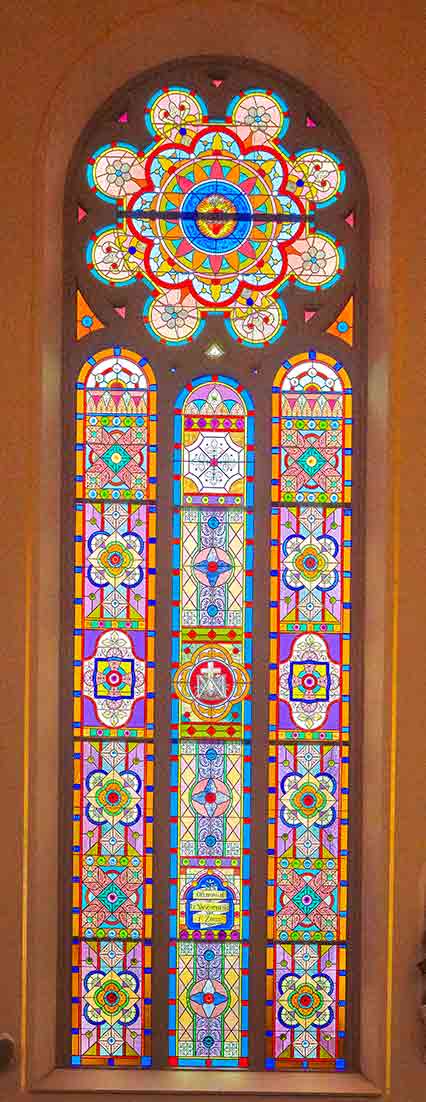
The tower held three bells: Maria (which counts the hours and tolls), Hedwig (which rings the Angelus) and Clemens. The four clocks, all five feet in diameter, were a gift from a non-Catholic, Mr. J Jung. Lighting was provided by 100 gas lamps, the heating came from steam which was located in the basement. There was also the cornerstone from the original church dated 1871. Immediately after the completion of the church, construction began on a new school as the current one was small and uncomfortable. The Archbishop supported this decision as the old church needed to be demolished. The church had eight Sisters plus one lay teacher who also played the organ for Mass. Once the church, school, and a residence for the Sisters were completed, a rectory was built and an associate Priest for the parish was named, Father Wladyslaw Mscisz.
A loan was taken out for $25,000 and the church generated income by tithes, renting out pews and school fees. The pews now generated $7000 per month.
The church provided health care of sorts; if a church member was sick two others would be sent to care for them and the church would pay $5 per week as long as the person was confined to a bed. Eight faith based brotherhoods were formed within the church as well as two secular ones to aid the needy in the community.
In 1893 the parish had again become so large that it deemed necessary to split it into two. Church members living in the 13th ward were organized into a new parish named for St. Casimir for which the members of St. Hedwig’s donated $6,000 in seed money.
In 1897 St. Hedwig’s celebrated its twenty fifth anniversary and one thousand silver and aluminum medals to commemorate the event were pressed and the local church hierarchy attended. Father Rogozinski would stay on as pastor of the church until 1901, when Father Bronislaus Celichowski would assume his duties. Father Chelichowski had been born in the Kcynia district of the Grand Duchy of Poznan and would guide St. Hedwigs for eight years. Following this he would then go onto minister at St. Casimir’s as well as SS. Cyril and Methodius. All told Father Celichowski spent fifty years serving Milwaukee’s Catholic community. The first son of St. Hedwigs would be ordained into the priesthood in 1897, Reverend Maximilian Dorszynski. He would be followed by 16 others.
In 1901, a two-manual organ with thirty-two stops was purchased at the price of $6400.
The ordination of the first native son of St. Hedwigs, Father Joseph Platta, took place in 1907.
From 1909 to 1911, Msgr. Gulski, formerly of St. Hyacinth, ministered to the flock at St. Hedwig’s. Msgr. Gulski passed away on the same day, on Christmas Eve 1911, as his own former pastor, Father Kralczynski. Msgr. Gulski was succeeded by Father Michael Wenta who presided over “the golden years” of St. Hedwig’s. Under Father Wenta’s direction, six additional classrooms were added to the school. Wenta, a learned scholar, had over 2,000 volumes in his personal library. The parish also constructed a comfortable home for the sisters who were serving St. Hedwig’s at a cost $60,000.
With the onset of World War I, several men from the parish served in the US Army. This included Father Mikolajcak who was commissioned as a US Army Chaplain in May of 1917. He served in the battles of Chateau Thierry, Meuse and Aragon. Following the war Father Mikolajcak was reassigned to his prewar position at St. Hedwig’s. For a period of time the Stoltman Post of the American Legion was founded at the Parish, named for the first parishoner from St. Hedwig’s who made the supreme sacrifice.
In October of 1921, the church celebrated its 50th anniversary and the school reached its peak enrollment of 1129 students the following year. Twenty one Sisters were now attached to the school and a new convent was built for them and completed the following year. But the Parish school began a slow decline in enrollment which followed the exodus of young couples to newer housing on the North side of the city. In an effort to keep young families in the church a new church hall was constructed which allowed young people to play basketball and hold dances, among other activities. St Hedwig’s boasted of its own Dramatic Society, which put on performances throughout Milwaukee.
Reverend Wenta was elevated to the post of Monsignor in recognition for his service to the church in 1925. It was during this time that language became an issue. The third-generation Poles preferred English and Italians were moving into the neighborhood. Msgr. Wenta introduced two English sermons one Sunday, which did not sit well with older members of the parish. In 1935, Msgr. Wenta was suddenly transferred to St. Stan, which came as a shock to the Parish. In appreciation for his services the parishioners organized a banquet and presented him with a new Dodge Coupe to replace his aging Chandler.
Father John Mikolajczak was chosen to replace Monsignor Wenta. Unfortunately, Father Mikolajczak had been exposed to mustard gas during the First World War while serving as a chaplain for the Army and suffered from ill health for the remainder of his life. Father Mikolajczak initiated a number of renovation projects to the church building and grounds but passed away on September 10, 1939 at the age of just 52 after a very long illness. He had served St. Hedwig’s for only four years.
Father Felix Goral was assigned as Father Mikolajczak’s replacement and immediately embarked on an ambitious plan to repair the church, bracing the roof with steel beams and then covering both the roof and steeple in copper. The old slate roof had become brittle, and falling pieces from it were creating a hazard for passersby. The interior of the church had not been decorated since 1909, and was, therefore, completely redone. The old church clock was also renovated and wired for electricity.
World War II came and the Parish supplied nearly 600 young men and women to the US Armed Forces, five of whom perished during the long conflict.
On September 19, 1943, organist Joseph Bejma was honored for his 50 years of service to the Parish. He retired and was replaced by Leo Muskatevc, who had received a Bachelor’s Of Music degree from Alverno College and a Masters from DePaul University.
In 1946, the church celebrated its diamond jubilee. This post-war period also spelled changes for the neighborhood around St. Hedwig’s. The younger generation of Polish-American, many with the assistance of G.I. loans, were opting for newer homes in other parts of the city. They began leaving the East Side and were replaced by Italian, Irish, and Hispanic residents.
On July 31st, 1952 Father Goral suffered a sudden and fatal heart attack and the parish was deeply saddened by his passing. Reverend Edmund Burczyk was named as his replacement and would serve the parish for the next seven years. During his tenure the church was once again remodeled and new pews and marble altars installed. In 1959 Father Burczyk was transferred to Blessed Sacrament and replaced by Father Joseph Lomasz who had come from St. Casimir parish in Kenosha.
While originally designed for seating 1150 parishioners, the capacity was reduced to 900 during a major renovation in 1957-9.
In the 1960s, Brady St. became the center for the counter culture movement in Milwaukee. As the neighborhood changed, so did the focus of St. Hedwig’s. The last Polish Mass was performed at the church in 1962. The altar was changed to face the congregation and guitar masses introduced to appeal to the growing youth element in the neighborhood. The adults of St. Hedwig’s organized a group called S.H.A.D.Y. - St. Hedwig’s Adults Dedicated to Youth, in an attempt to address social challenges facing the younger generation during the rebellious 60s.
Father Lomasz eventually left St. Hedwigs and was replaced by Reverend Victor Sleva. In 1968, Father Welczewski succeeded Reverend Sleva as pastor and was followed just one year later by Father Yaniak.
A jubilee mass to celebrate the 100th anniversary of the church was held on Saturday October 16, 1971 celebrated by Rev. Msgr. Sylvester P. Peters, Ph. D. The next day Archbishop William E. Cousins presided over a special Mass for the benefit of the parish.
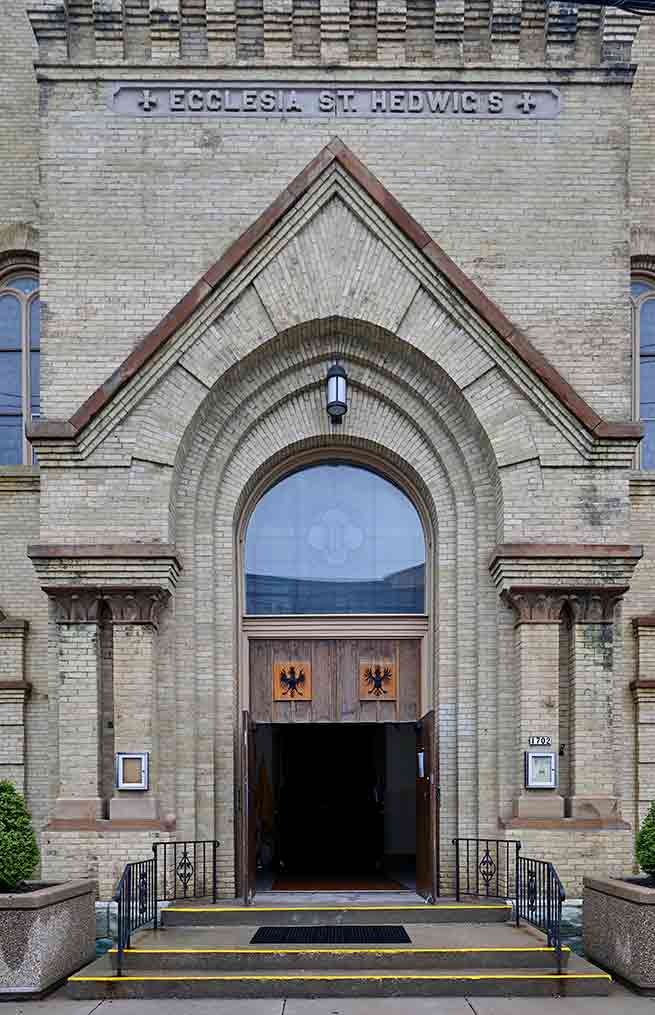
In the 1970s, an attempt was made to clean the brick of the church from the decades of soot and grime. It was, unfortunately, largely unsuccessful and left dark spots on the bricks. In the 1980s the doors of the church were replaced and embellished with two wrought iron eagles made by Eric Moebius, one eagle representing Poland and the other the Duchy of Silesia. The original doors from the church were moved to the north side of the sacristy. The stained glass windows were cleaned and releaded. A reconciliation and brides’ room were also added under the choir loft in 1983. In addition, six windows in the choir loft and top halves of the large windows were plastered over on the inside. Two windows on the rear wall of the sanctuary remained but were now hidden from public view inside the church.
The only original decoration in the church, a painting by the Polish artist Zugotynski, was also removed from view by the new wall. Doris Wokurka, another Polish artist, painted the depiction of St Hedwig in the 1980s. Jerzy Kenar, a resident of Chicago, carved the baptismal font, as well as the two works of art on either side of the interior entrance.
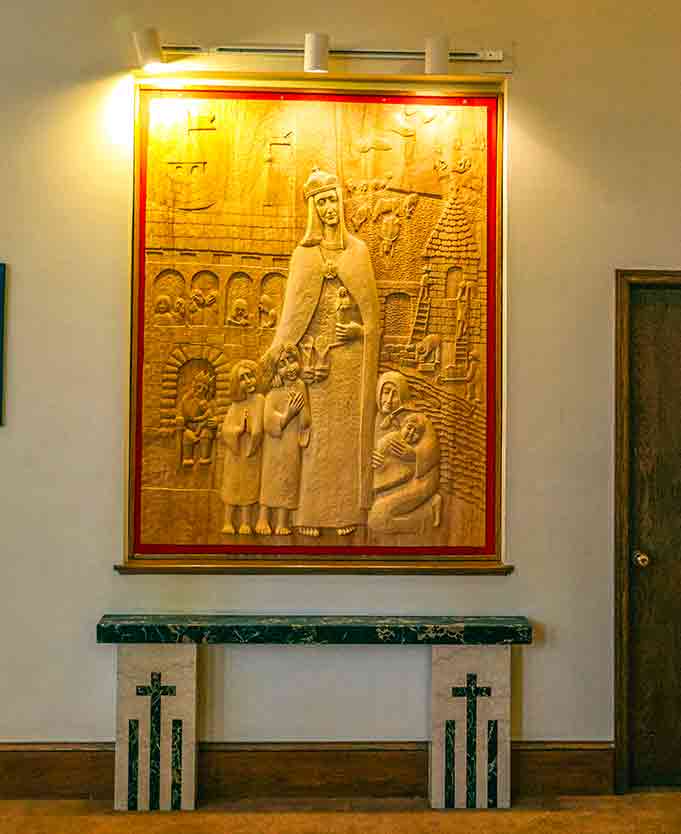
In 1983, a thief was apprehended dragging the Stations of the Cross from the church down the street. Luckily, the work had not been damaged in the process. The Stations had originally been created by Hermann Moroder of St. Ulrich, Austria in the 1920s. Moroder was famous for having also carved the presidential and two side arm chairs which had won a prize at the Century of Progress Exposition in Chicago in 1933. In the 1980s the Perpetual Help Icon was also the victim of a theft, but recovered by Milwaukee police just a few days later.

As the congregation continued to change, St. Hedwig’s parish was merged with Holy Rosary and St. Rita to form Three Holy Women Parish in 1999. The parish is enjoying a renaissance of sorts now, under the guidance of Father Tim, who brings a special enthusiasm and passion to his work in the parish.
All photos by Marcin Murawski.




